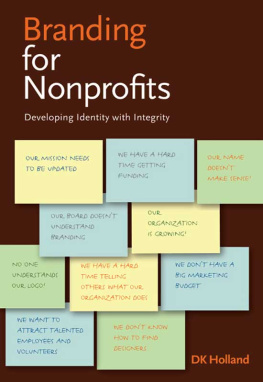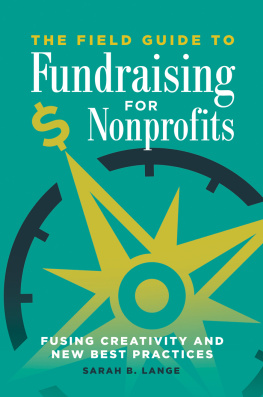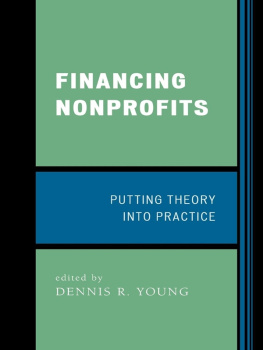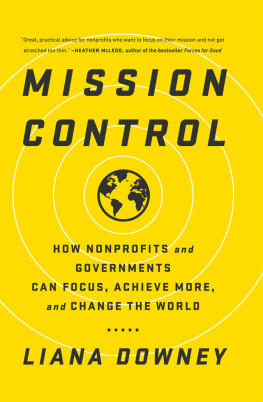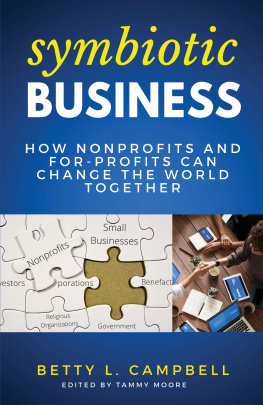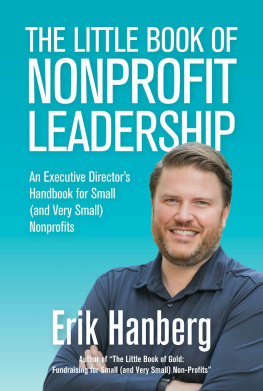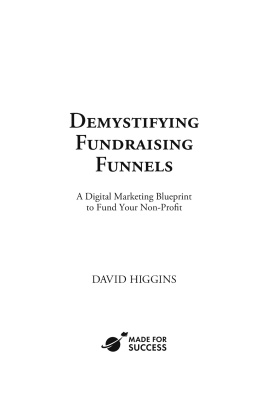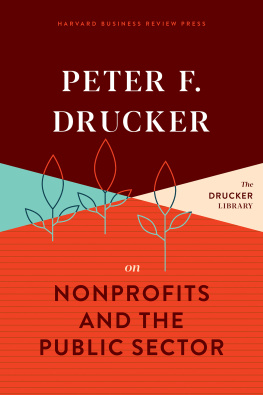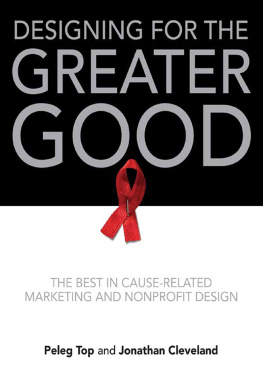Branding
for
Nonprofits:
Developing Identity with Integrity
Branding
for
Nonprofits:
Developing Identity with Integrity
DK Holland

2006 DK Holland
All rights reserved. Copyright under Berne Copyright Convention, Universal Copyright Convention, and Pan-American Copyright Convention. No part of this book may be reproduced, stored in a retrieval system, or transmitted in any form, or by any means, electronic, mechanical, photocopying, recording, or otherwise, without prior permission of the publisher.
10 09 08 07 06 5 4 3 2 1
Published by Allworth Press
An imprint of Allworth Communications, Inc.
10 East 23rd Street, New York, NY 10010
Cover and interior design by Whitehouse & Company, New York Typography by SR Desktop Services, Ridge, NY
ISBN: 1-58115-434-8
ISBN 9781581158427
Library of Congress Cataloging-in-Publication Data
Holland, DK.
Branding for nonprofits : developing identity with integrity / DK Holland.
p. cm.
Includes index.
1. Brand name products. 2. Nonprofit organizations Marketing. I. Title.
HD69.B7H645 2006
658.8'27dc22
2005026430
Printed in Canada
Dedication
In 1831, while the young Alexis de Tocqueville traveled the rough terrain of our fledgling United States, he witnessed the remarkable optimism, energy, and faith of the people he met along the way. The notion that change was possible against the odds was palpable. Later, in Democracy in America, he told the world about this phenomenonthis uniquely American can-do attitude, an attitude that would soon become part of the brand of the United States of America.
The nonprofit and branding systems are also, not coincidentally, unique to the United States. And this book is dedicated to those Americans of the twenty-first century who are the future of nonprofits: those generous, creative, savvy Americans who will use the force of optimismand their branding skillsto push the world forward.
Acknowledgments
A phone call in the winter of 2003 led me to Mitch Nauffts, editor of Philanthropy News Digest (PND), the online publication of The Foundation Center. I had conducted two seminars there on branding for nonprofits that had been very well received and suggested to him that I follow up by writing an article, and he said, to my delight, How about an ongoing column?
My first thought was that it would be best to present the process of branding chronologically and explore a phase in each column so that the reader would better grasp the importance of sequencing in the stages of development. It would make a good book, I said. Having produced over a dozen books on design, I had no problem imagining it. So thanks to Mitch for his support as Nonprofits by Design rolled out online over the course of two years. His skeptical mind and keen editing skills made a big difference to this book.
Thanks to Judie Gilmore for her help and endless enthusiasm for this project. Her insatiable curiosity and commitment to social change gives me hope for the future.
Thanks to Ed Pusz, design director at the Museum of Modern Art, for providing the foreword for this book. MoMA was the first nonprofit brand I chose to interview for my online column and it remains the pinnacle of nonprofit branding, as far as Im concerned.
, On the Evolution of Branding (the only chapter in the book that did not appear in PND).
When most of the columns were online, I contacted Tad Crawford, president of Allworth Press, publisher of virtually all the books I have ever published and a longtime good friend and ally. I thank Tad for once again having the confidence to see this book through to the marketplace.
Thanks for my longtime colleagues and dear friends, graphic designers Roger Whitehouse, Ben Whitehouse, and Saki Tanaka, for the inspired design of the cover and interior of this book.
Finally, thanks to all the readers of PNDs Nonprofits by Designespecially those who contacted me to say that the column was providing them with important resources and support. It is for them that I created this book.
DK Holland
New York, N.Y.
Foreword
In one of my earliest meetings with Terence Riley, chief curator of the architecture and design department, he interrupted a presentation to inform me, Here at the Museum of Modern Art, we dont use the word brand. We prefer the term spirit. At first I found his statement a semantic matter that comes along with understanding your clients language. Through many years of archival research and countless hours of listening to the oral history of the Museum, Ive come to see the wisdom of his words.
What can be found at the heart of all successful nonprofits, regardless of size, is the motivational force of intention. Shared intention, otherwise know as the mission, binds together dedicated individuals with a common desire to effect positive change on the world around us. This spirit of intention is the mark of a great company nonprofit or otherwiseand it invigorates the entire organization, from its leadership and staff to the products or services it delivers.
It did feel awkward using the now-banished term brand outside of the safety of the design department. MoMAs graphic designers have the benefit and pleasure of working in a place steeped in design history and populated by visually astute colleagues. Yet our work, if its done well, should disappear and not call attention to itself. It was therefore no surprise when research showed a much higher public association with
Van Goghs Starry Night and Picassos Les Demoiselles dAvignon than with the Museums logo or typographic style. Without losing sight of our supporting role, we spent the next four years understanding the unique qualities of MoMA as it undertook the most ambitious building project in its history. Our branding process paralleled many of the steps prescribed within these pages, contributing to the smooth implementation of the Museums new visual identity program.
When DK Holland first shared her online column at a resource site for nonprofits, I was certain it had the potential to be a great book. As with any other trade, designers can dissect a concept into abstraction when talking amongst themselves. DK makes these ideas accessible, tangible, and entertaining. It gives me great pleasure to know that she is using her many years of experience within the design community and directing it outwards. This publication brings together insights from some of the great visual communicators of our time, with DK as your friend and guide. Through these pages she will lead you through the entire process and show you the way to an authentic, successful, and sustainable brandor whatever you choose to call it.
Ed Pusz, Director
Department of Graphic Design
The Museum of Modern Art
Branding
for
Nonprofits:
Developing Identity with Integrity
One
Whats That Branding Buzz I Hear? And Why Nonprofits Cant Afford to Ignore It
Cowboys all know you cant brand nothin till you tie three of its legs together, slam it to the ground, and sedate it.
Bart Crosby, brand designer
Everything gets branded, one way or anotherwhether its a consumer product, a movie star, a political cause, a religion... even a nonprofit organization. Branding cant be avoided, and, in fact, it should be embraced by all nonprofits. After all, its how you tell your story and its at the heart of all outreach efforts.
Everyone wants to get attention. But the most organized, consistently delivered brands are the ones that people respond to. Why? Because they are the brands that communicate clearly to their audiencesand in response, people understand, know, and trust these brands.
Next page
